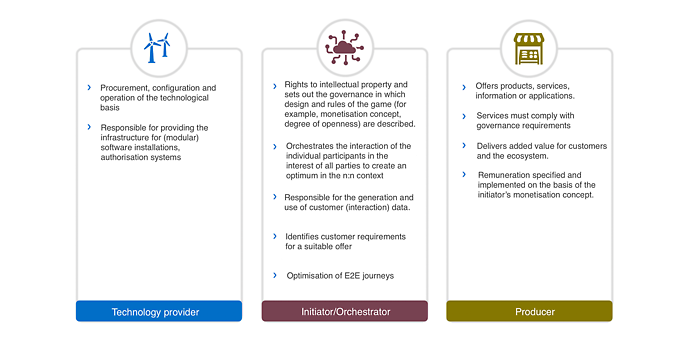30. July 2021 By Michael Bünnemeyer
Into the ecosystem? Win over insured persons digitally – where they are
Max Meier is 20 years old and loves his bike, which he cherishes, maintains and keeps as technically up-to-date as possible – as far as his bank balance allows. A comparison platform for bicycles and accessories gives him information on various trends and bargains – be it high-quality brake discs or the latest pedal system, this is where Max gets the best overview. Max is particularly pleased about the option he has to extend the guarantee for his purchases or specifically insure them. In this context, Max is not bothered about which insurer covers the risk in the background.
Shopping triggers positive feelings in Max and heightens the feeling of anticipation he has for the desired new items before they are delivered. But even without buying anything, Max is happy to have found a website that offers him so many added benefits.
So much for an example of a functioning ecosystem. My intention is not to convey a set of utopian ideas with this blog post. Instead, I aim to point out and sensitise you to the opportunities provided by ecosystems for addressing customers for the insurance industry. The above example shows almost too perfectly where the insurance market and communication with customers are heading in the coming years. But let’s start with the theory first. What is an ecosystem? What are the driving forces and what opportunities does an ecosystem offer individual participants?
The ecosystem in theory
According to Fraunhofer IESE n ecosystem is a socio-technical system that not only includes digital and technical systems, but explicitly incorporates organisations and people and their relationships with each other. In a common digital ecosystem, participants act on the basis of mutual benefits that arise from joint cooperation in the ecosystem.
The benefit achieved exceeds the sum of the individual services provided by the companies involved in the ecosystem and this is what makes it different from a mere network or a linear value chain.
This is the 1 + 1 = 3 principle where different components (for example, pedals and an extended warranty), which have a low value individually, are combined to create added value (such as satisfaction, enthusiasm or safety).
People and technology, in particular, play a leading role in building and developing an ecosystem. People determine the success of an ecosystem through their actions. The system must be tailored to their needs. As a rule, linear value chains and networks already exist to meet demands. When it comes to end consumers, needs are met through areas of life such as hobbies and passions.
Technological progress enables new forms of networking and therefore acts as a catalyst. In ecosystems, new products and services can be developed that generate their own demand and therefore create a new market.
The actors in an ecosystem (without considering the customer) can take on the following roles in particular:

To give an example from another industry, Netflix is the initiator/orchestrator for its streaming service and produces its own series as a product (for example, see ‘Money Heist’). The technology provider for computing and storage requirements, including databases, is AWS. Similar constructs can also be found in the German insurance market.
Seizing opportunities
An ecosystem offers insurers the opportunity to engage directly with customers while they are in an environment that is positive for them. The specific insurance product is integrated into the overall offer. It is important to note that simple composite insurance, such as property and liability, generates little demand on the customer or insurer side, unlike pension or health products. This means that the hurdle to be overcome in order to conclude a policy can vary depending on the insurance product. The fact that an insurer’s own brand can fade into the background in the process poses a particular challenge for insurers.
A positive aspect for the customer is their personal customer journey, where they can buy insurance cover without any additional effort. This is at the expense of a neutral comparison and there is a risk that the customer will buy insurances that may already be available or they will tend to lose track of the different insurances they have for their objects (for pedals, tyres, and so on). This reminds me a little of the moment when you want to obtain another overview of the streaming services you’ve paid for.
This direct contact between customers and platforms/insurers does not necessarily mean that brokers lose out. Instead, the low-threshold purchasing of the product helps to generate contacts and therefore leads that could also prove to be interesting for brokers as soon as further advice and guidance is required for the products. When networking with platforms, large brokerage houses can position themselves as comparators, for example, that can offer the optimal product depending on the constellation of the products purchased – for example, the age of the customer, financial framework conditions, and so on.
To conclude, it is important to note that the insurance industry must specifically address the topic of ecosystems – in particular, as a producer or, in rarer cases, as an initiator/orchestrator.
Would you like to learn more about exciting topics from the world of adesso? Then check out our latest blog posts.

